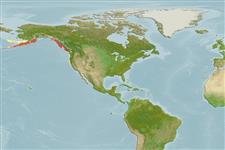>
Perciformes/Cottoidei (Sculpins) >
Cottidae (Sculpins)
Etymology: Ruscarius: Latin, ruscarius, -a- um = with tangled hair; meanyi: Named after Prof. E.S. Meany of the University of Washington (Ref. 6885).
More on authors: Jordan & Starks.
Environment: milieu / climate zone / depth range / distribution range
Ecologia
marino demersale; distribuzione batimetrica 2 - 82 m (Ref. 2850). Temperate; 59°N - 38°N
Eastern Pacific: Fillmore Island, southeastern Alaska to Arena Cove, northern California, USA.
Size / Peso / Age
Maturity: Lm ? range ? - ? cm
Max length : 5.9 cm TL maschio/sesso non determinato; (Ref. 2850)
Spine dorsali (totale): 10; Raggi dorsali molli (totale): 15-16; Spine anali 0; Raggi anali molli: 11 - 12. Caudal fin bluntly rounded. Pelvic fins small.
Inhabits intertidal and subtidal areas, on rocks or vertical rock faces (Ref. 2850).
Life cycle and mating behavior
Maturità | Riproduzione | Deposizione | Uova | Fecundity | Larve
Matarese, A.C., A.W. Kendall, D.M. Blood and M.V. Vinter, 1989. Laboratory guide to early life history stages of Northeast Pacific fishes. NOAA Tech. Rep. NMFS 80:1-652. (Ref. 265)
IUCN Red List Status (Ref. 130435)
Threat to humans
Harmless
Human uses
Informazioni ulteriori
Nomi ComuniSinonimiMetabolismoPredatoriEcotossicologiaRiproduzioneMaturitàDeposizioneSpawning aggregationFecundityUovaEgg development
BibliografiaAcquacolturaProfilo di acquacolturaVarietàGeneticaElectrophoresesEreditarietàMalattieElaborazioneNutrientsMass conversion
CollaboratoriImmaginiStamps, Coins Misc.SuoniCiguateraVelocitàModalità di nuotoArea branchialeOtolithsCervelliVista
Strumenti
Special reports
Download XML
Fonti Internet
Estimates based on models
Preferred temperature (Ref.
123201): 5.6 - 10.7, mean 8.6 °C (based on 120 cells).
Phylogenetic diversity index (Ref.
82804): PD
50 = 0.7500 [Uniqueness, from 0.5 = low to 2.0 = high].
Bayesian length-weight: a=0.00794 (0.00389 - 0.01621), b=3.12 (2.95 - 3.29), in cm total length, based on LWR estimates for this (Sub)family-body shape (Ref.
93245).
Trophic level (Ref.
69278): 3.2 ±0.5 se; based on size and trophs of closest relatives
Resilienza (Ref.
120179): Alto, tempo minimo di raddoppiamento della popolazione meno di 15 mesi (Preliminary K or Fecundity.).
Fishing Vulnerability (Ref.
59153): Low vulnerability (10 of 100).
